牛津上海版英语一轮复习学案主谓一致
文档属性
| 名称 | 牛津上海版英语一轮复习学案主谓一致 | 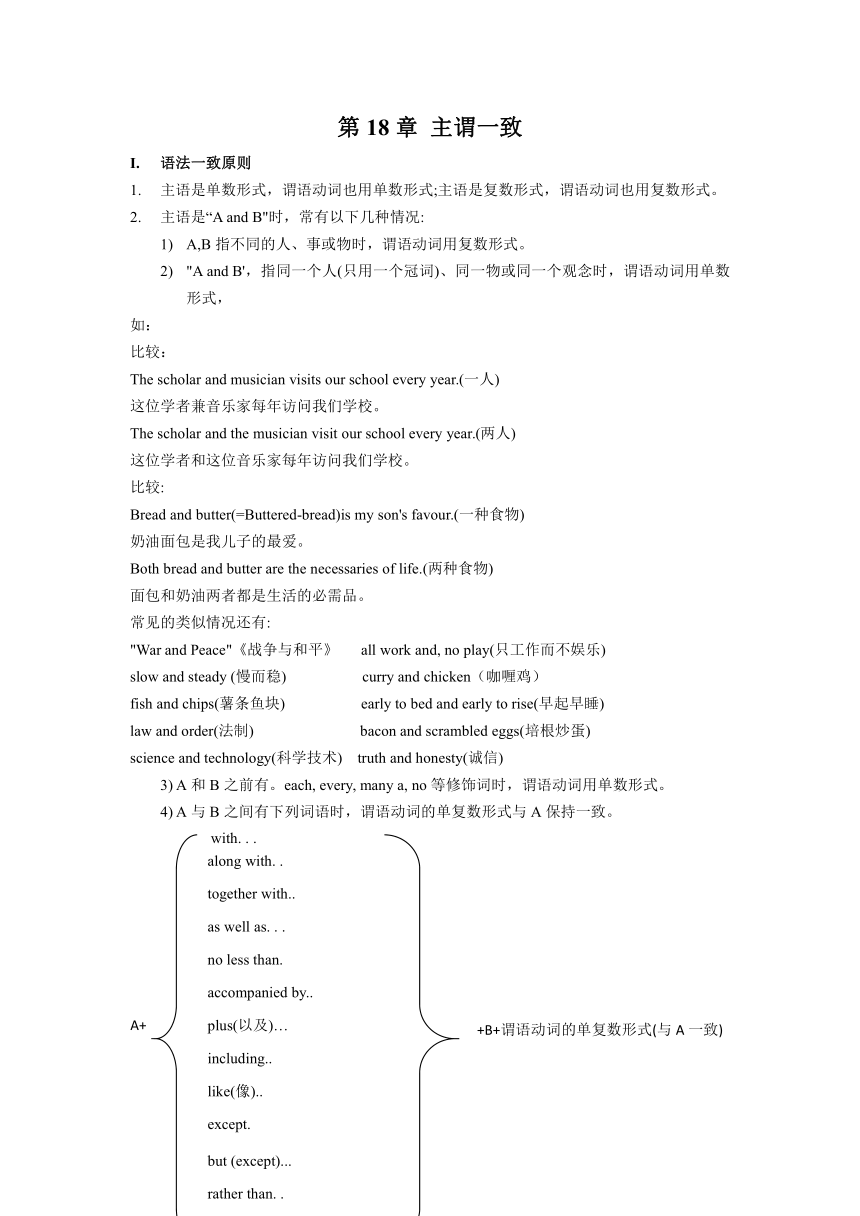 | |
| 格式 | docx | ||
| 文件大小 | 39.4KB | ||
| 资源类型 | 教案 | ||
| 版本资源 | 牛津上海版(试用本) | ||
| 科目 | 英语 | ||
| 更新时间 | 2020-10-25 22:25:39 | ||
图片预览

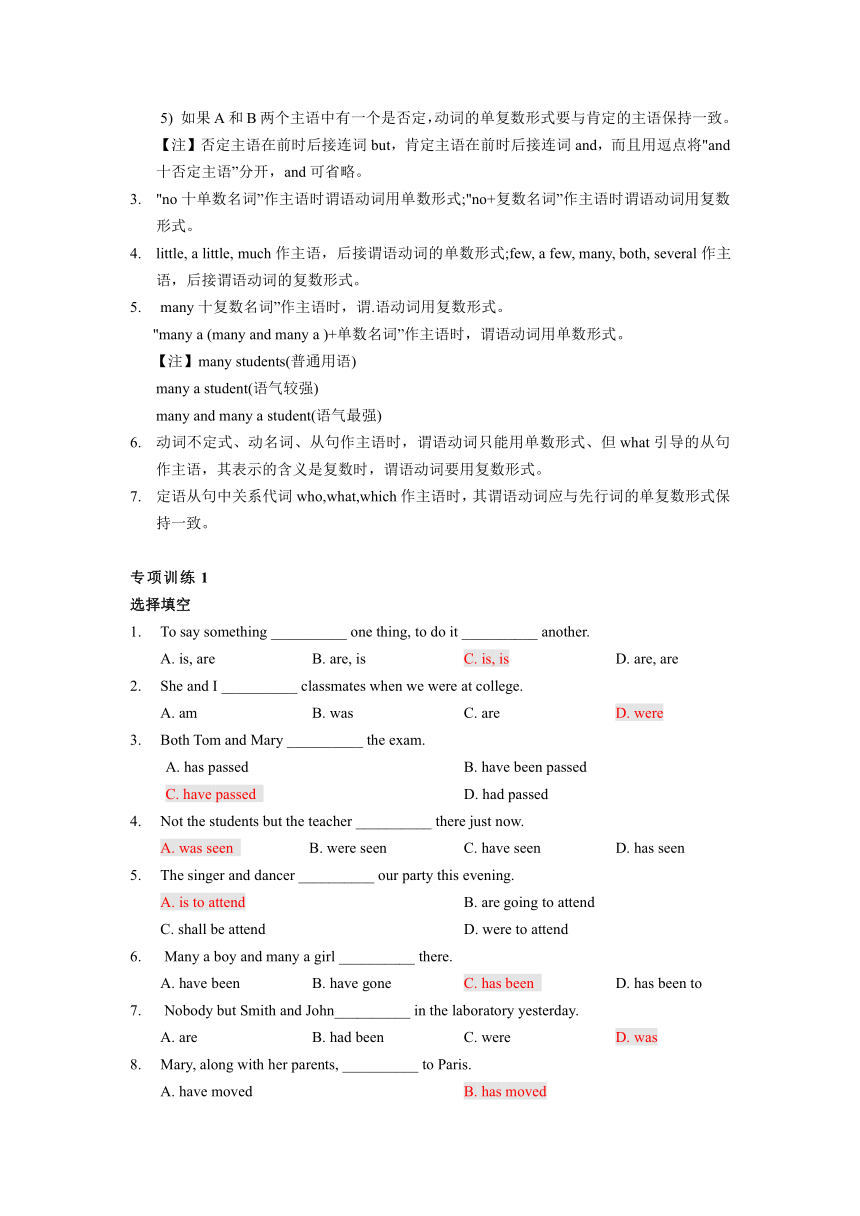
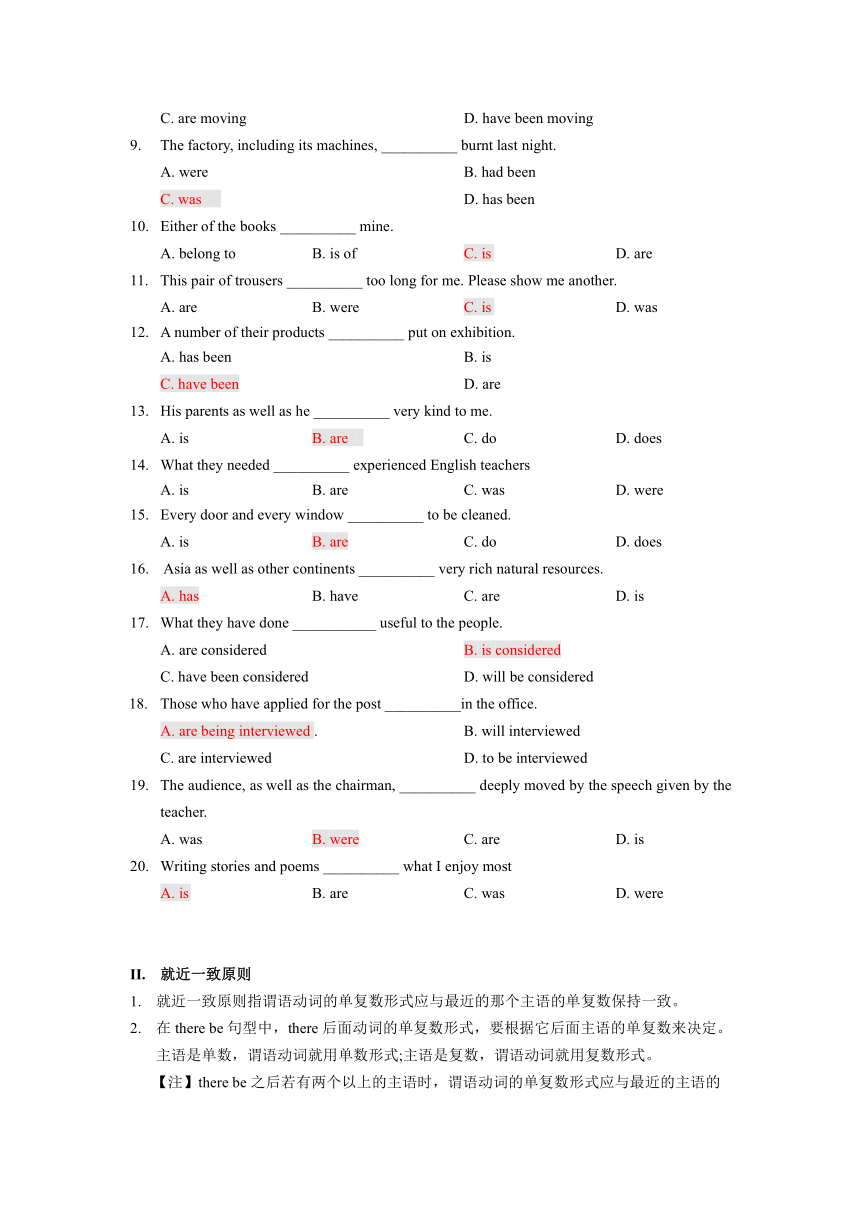
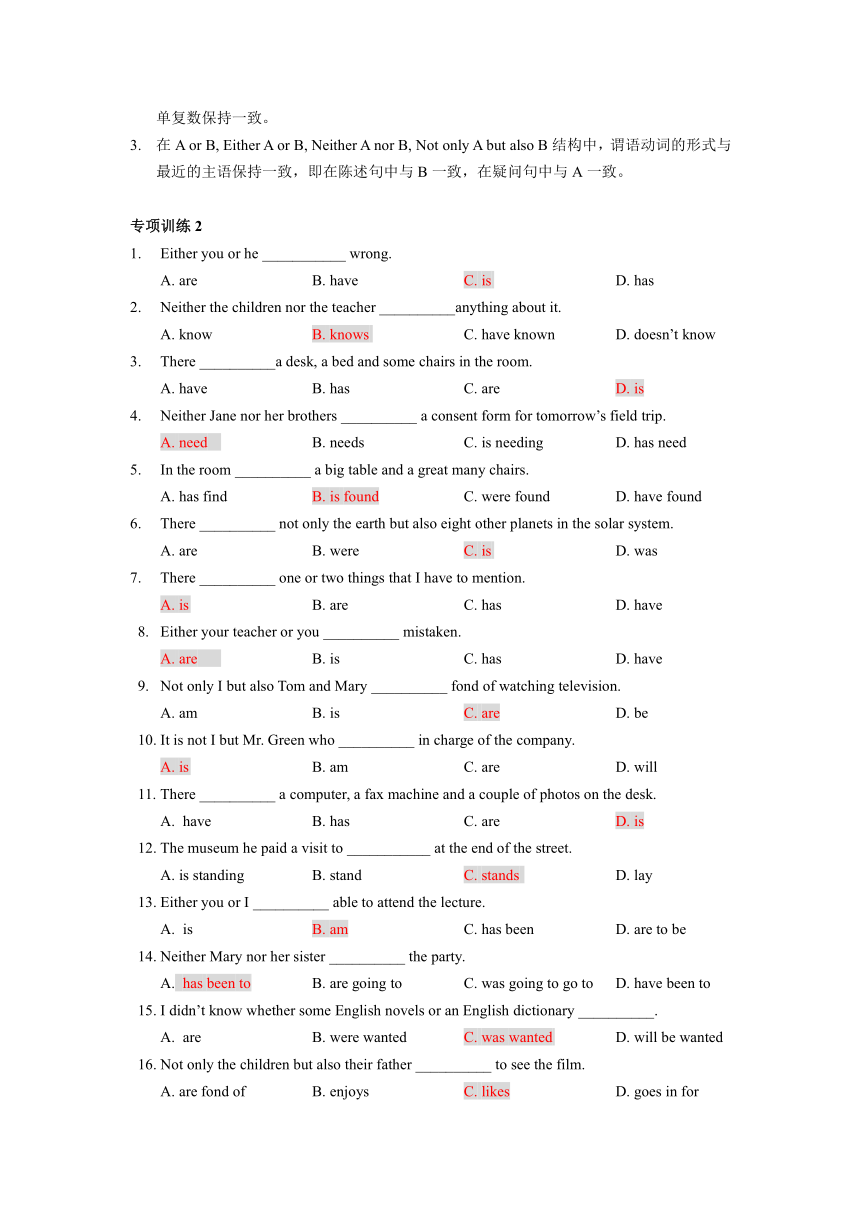
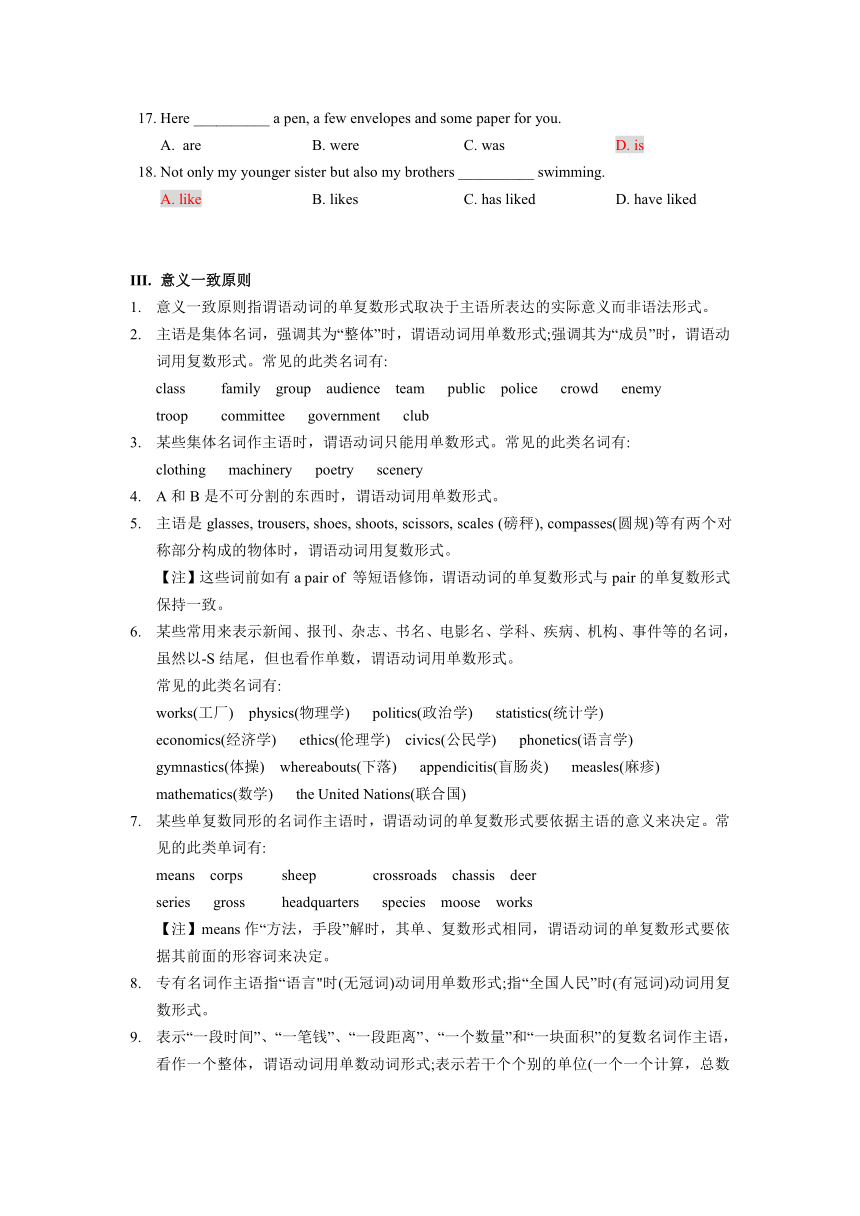
文档简介
第18章 主谓一致
I. 语法一致原则
1. 主语是单数形式,谓语动词也用单数形式;主语是复数形式,谓语动词也用复数形式。
2. 主语是“A and B"时,常有以下几种情况:
A,B指不同的人、事或物时,谓语动词用复数形式。
"A and B',指同一个人(只用一个冠词)、同一物或同一个观念时,谓语动词用单数形式,
如:
比较:
The scholar and musician visits our school every year.(一人)
这位学者兼音乐家每年访问我们学校。
The scholar and the musician visit our school every year.(两人)
这位学者和这位音乐家每年访问我们学校。
比较:
Bread and butter(=Buttered-bread)is my son's favour.(一种食物)
奶油面包是我儿子的最爱。
Both bread and butter are the necessaries of life.(两种食物)
面包和奶油两者都是生活的必需品。
常见的类似情况还有:
"War and Peace"《战争与和平》 all work and, no play(只工作而不娱乐)
slow and steady (慢而稳) curry and chicken(咖喱鸡)
fish and chips(薯条鱼块) early to bed and early to rise(早起早睡)
law and order(法制) bacon and scrambled eggs(培根炒蛋)
science and technology(科学技术) truth and honesty(诚信)
3) A和B之前有。each, every, many a, no等修饰词时,谓语动词用单数形式。
with. . .
4) A与B之间有下列词语时,谓语动词的单复数形式与A保持一致。A+
in addition to(=besides)等
rather than. .
but (except)...
except.
like(像)..
including..
plus(以及)…
accompanied by..
no less than.
as well as. . .
together with..
along with. .
+B+谓语动词的单复数形式(与A一致)
5) 如果A和B两个主语中有一个是否定,动词的单复数形式要与肯定的主语保持一致。
【注】否定主语在前时后接连词but,肯定主语在前时后接连词and,而且用逗点将"and十否定主语”分开,and可省略。
3. "no十单数名词”作主语时谓语动词用单数形式;"no+复数名词”作主语时谓语动词用复数形式。
4. little, a little, much作主语,后接谓语动词的单数形式;few, a few, many, both, several作主语,后接谓语动词的复数形式。
5. many十复数名词”作主语时,谓.语动词用复数形式。
"many a (many and many a )+单数名词”作主语时,谓语动词用单数形式。
【注】many students(普通用语)
many a student(语气较强)
many and many a student(语气最强)
动词不定式、动名词、从句作主语时,谓语动词只能用单数形式、但what引导的从句作主语,其表示的含义是复数时,谓语动词要用复数形式。
定语从句中关系代词who,what,which作主语时,其谓语动词应与先行词的单复数形式保持一致。
专项训练1
选择填空
1. To say something __________ one thing, to do it __________ another.
A. is, are B. are, is C. is, is D. are, are
2. She and I __________ classmates when we were at college.
A. am B. was C. are D. were
3. Both Tom and Mary __________ the exam.
A. has passed B. have been passed
C. have passed D. had passed
4. Not the students but the teacher __________ there just now.
A. was seen B. were seen C. have seen D. has seen
5. The singer and dancer __________ our party this evening.
A. is to attend B. are going to attend
C. shall be attend D. were to attend
6. Many a boy and many a girl __________ there.
A. have been B. have gone C. has been D. has been to
7. Nobody but Smith and John__________ in the laboratory yesterday.
A. are B. had been C. were D. was
8. Mary, along with her parents, __________ to Paris.
A. have moved B. has moved
C. are moving D. have been moving
9. The factory, including its machines, __________ burnt last night.
A. were B. had been
C. was D. has been
10. Either of the books __________ mine.
A. belong to B. is of C. is D. are
11. This pair of trousers __________ too long for me. Please show me another.
A. are B. were C. is D. was
12. A number of their products __________ put on exhibition.
A. has been B. is
C. have been D. are
13. His parents as well as he __________ very kind to me.
A. is B. are C. do D. does
14. What they needed __________ experienced English teachers
A. is B. are C. was D. were
15. Every door and every window __________ to be cleaned.
A. is B. are C. do D. does
16. Asia as well as other continents __________ very rich natural resources.
A. has B. have C. are D. is
17. What they have done ___________ useful to the people.
A. are considered B. is considered
C. have been considered D. will be considered
18. Those who have applied for the post __________in the office.
A. are being interviewed . B. will interviewed
C. are interviewed D. to be interviewed
19. The audience, as well as the chairman, __________ deeply moved by the speech given by the teacher.
A. was B. were C. are D. is
20. Writing stories and poems __________ what I enjoy most
A. is B. are C. was D. were
II. 就近一致原则
就近一致原则指谓语动词的单复数形式应与最近的那个主语的单复数保持一致。
在there be句型中,there后面动词的单复数形式,要根据它后面主语的单复数来决定。主语是单数,谓语动词就用单数形式;主语是复数,谓语动词就用复数形式。
【注】there be之后若有两个以上的主语时,谓语动词的单复数形式应与最近的主语的
单复数保持一致。
在A or B, Either A or B, Neither A nor B, Not only A but also B结构中,谓语动词的形式与最近的主语保持一致,即在陈述句中与B一致,在疑问句中与A一致。
专项训练2
1. Either you or he ___________ wrong.
A. are B. have C. is D. has
2. Neither the children nor the teacher __________anything about it.
A. know B. knows C. have known D. doesn’t know
3. There __________a desk, a bed and some chairs in the room.
A. have B. has C. are D. is
4. Neither Jane nor her brothers __________ a consent form for tomorrow’s field trip.
A. need B. needs C. is needing D. has need
5. In the room __________ a big table and a great many chairs.
A. has find B. is found C. were found D. have found
6. There __________ not only the earth but also eight other planets in the solar system.
A. are B. were C. is D. was
7. There __________ one or two things that I have to mention.
A. is B. are C. has D. have
8. Either your teacher or you __________ mistaken.
A. are B. is C. has D. have
9. Not only I but also Tom and Mary __________ fond of watching television.
A. am B. is C. are D. be
10. It is not I but Mr. Green who __________ in charge of the company.
A. is B. am C. are D. will
11. There __________ a computer, a fax machine and a couple of photos on the desk.
have B. has C. are D. is
12. The museum he paid a visit to ___________ at the end of the street.
A. is standing B. stand C. stands D. lay
13. Either you or I __________ able to attend the lecture.
is B. am C. has been D. are to be
14. Neither Mary nor her sister __________ the party.
has been to B. are going to C. was going to go to D. have been to
15. I didn’t know whether some English novels or an English dictionary __________.
are B. were wanted C. was wanted D. will be wanted
16. Not only the children but also their father __________ to see the film.
A. are fond of B. enjoys C. likes D. goes in for
17. Here __________ a pen, a few envelopes and some paper for you.
are B. were C. was D. is
18. Not only my younger sister but also my brothers __________ swimming.
A. like B. likes C. has liked D. have liked
III. 意义一致原则
意义一致原则指谓语动词的单复数形式取决于主语所表达的实际意义而非语法形式。
主语是集体名词,强调其为“整体”时,谓语动词用单数形式;强调其为“成员”时,谓语动词用复数形式。常见的此类名词有:
class family group audience team public police crowd enemy
troop committee government club
某些集体名词作主语时,谓语动词只能用单数形式。常见的此类名词有:
clothing machinery poetry scenery
A和B是不可分割的东西时,谓语动词用单数形式。
主语是glasses, trousers, shoes, shoots, scissors, scales (磅秤), compasses(圆规)等有两个对称部分构成的物体时,谓语动词用复数形式。
【注】这些词前如有a pair of 等短语修饰,谓语动词的单复数形式与pair的单复数形式保持一致。
某些常用来表示新闻、报刊、杂志、书名、电影名、学科、疾病、机构、事件等的名词,虽然以-S结尾,但也看作单数,谓语动词用单数形式。
常见的此类名词有:
works(工厂) physics(物理学) politics(政治学) statistics(统计学)
economics(经济学) ethics(伦理学) civics(公民学) phonetics(语言学)
gymnastics(体操) whereabouts(下落) appendicitis(盲肠炎) measles(麻疹)
mathematics(数学) the United Nations(联合国)
某些单复数同形的名词作主语时,谓语动词的单复数形式要依据主语的意义来决定。常见的此类单词有:
means corps sheep crossroads chassis deer
series gross headquarters species moose works
【注】means作“方法,手段”解时,其单、复数形式相同,谓语动词的单复数形式要依据其前面的形容词来决定。
专有名词作主语指“语言"时(无冠词)动词用单数形式;指“全国人民”时(有冠词)动词用复数形式。
表示“一段时间”、“一笔钱”、“一段距离”、“一个数量”和“一块面积”的复数名词作主语,看作一个整体,谓语动词用单数动词形式;表示若干个个别的单位(一个一个计算,总数超过一个)时,谓语动词用复数形式。
all, none ,any, some, more和most等不定代词作主语,代表或修饰单数名词或代词时,谓语动词用单数形式,代表或修饰复数名词或代词时,谓语动词用复数形式。
代词some(后面没有名词)指人时一定是复数(=some people),作主语时后接谓语动词的复数形式。
"none of+不可数名词”之后的谓语动词必定是单数形式。
"none of+复数名词”之后的谓语动词在正式场合下用单数形式;但在一般的、非常正式的场合下通常都用复数形式;若要强调单数形式的观念,则用no one或not one代替。
no one, nobody, not one of后接复数名词作主语时,谓语动词用单数形式。
the rest of
half of
half of
most of
some of
part of
+单、复数名词+动词的单数形式
a series of
a type of
a sort of
a kind of
被下列词语所修饰时,主语无论是单数还是复数,谓语动词均用单数形式:
当主语表示“部分”的意思时,谓语动词的单复数形式要根据主语后名词的单复数而定。
【注】all作主语代表人、或动物(后面没有of短语)时,谓语动词用复数形式;代表事或物时,谓语动词用单数形式。
all of
其他分数
+复数名词+动词的复数形式
+单数名词+动词的单数形式
percentage of
the remainder of
常见的此类词语有:
下列词语修饰主语时,谓语动词的单复数形式要依据被修饰词的单复数来决定。
a lot of
+不可数名词+动词的单数形式
+可数名词十动词的复数形式
lots of
a large /small quantity of
quantities of
plenty of
下列词语修饰主语时,谓语动词要用复数形式。
+复数名词+动词的复数形式
a couple of
a group of
"the number of+复数名词”作主语时,谓语动词用单数形式。
"a (great, good ,large) number of+复数名词”作主语时,谓一语动词用复数形式。
"the十形容词”代表单数名词作主语时,谓语动词用单数形式;代表复数名词作主语时,谓语动词用复数形式。
代词such作主语指人时为复数,相当于such persons,谓语动词要用复数形式;指事或物时,要根据其含义决定谓语动词的单复数形式。
【注】such作形容词修饰可数名词的单数时,必须用‘`such a+名词”,其中的a或an不可遗漏。
more than one / a(不止一个)修饰主语时,谓语动词用单数形式。
more than two(不只两个)修饰主语时,谓语动词用复数形式。
one or two(一两个)作主语或修饰主语时,谓语动词用复数形式。
a . . . or two(一两个)作主语或修饰主语时,谓语动词用单数形式。
在“one of十复数名词+定语从句”的结构中,定语从句中的谓语动词要用复数形式。而在“the only one of+复数动词+定语从句”的结构中,定语从句中的谓语动词要用单数形式。
算术式中谓语动词的单复数形式用法如下:
加法与乘法中谓语动词用单数形式和复数形式均可。
【注】a)加法中的“加”用介词plus不用and时,只能用动词的单数形式。
b)乘法中的times之后是。one时,只能用动词的单数形式。
c)乘法中的乘用multiplied by不用times时,只能用动词的单数形式。
2) 减法与除法中谓语动词用单数形式。
专项训练 3
选择填空。
Twenty miles __________ a long way to walk.
A. have B. are C. has D. is
2. The New York Times __________ a wide circulation.
A. is B. has C. are D. have
3. The Philippines __________ in the Pacific Ocean.
A. is B. belong to C. are D. lies
4. Mathematics __________ a very important subject.
A. are B.is C. were D. was
5. His mathematics __________ weak.
A. is B. have C. has D. are
6. Every means __________ tried to improve teaching and learning.
A. has B. has been C. have D. were
7. The police __________ searching for a tall dark man with long hair.
A. is B. has been C. are D. had been
8. The Chinese people __________ brave and hard-working.
A. is B. was C. has been D. are
9. The Chinese people __________ a brave and hard-working one.
A. is B. are C. have been D. were
10. My family __________ wonderful. They do all they can for me.
A. is B. are C. was D. were
11. The football team __________ baths now.
A. has B. is having C. are having D. have
12. Not all food __________ good for health.
A. is B. are C. was D. were
13. One third of the population here __________ workers.
A. was B. were C. are D. is
14. Most of the wood __________ to make furniture.
A. were used B. have been used C. had been used D. was used
15. The police __________ on the track of the criminals.
A. are B. is C. has been D. are being
16. Those are mine; the rest __________ yours.
A. is B. will be C. are D. belong to
17. She is the only one of the students who __________ praised.
A. were B. was C. has D. have been
18. All the data__________ once and again, and still there are a lot of mistakes.
A. has been checked B. have been checked C. has checked D. is checked
19. The firsts part of the lecture was interesting, but the rest __________ dull.
A. was B. were C. had been D. is
20. The committee __________ among themselves for four years.
A. has been arguing B. has been argued C. have been arguing D. have been argued
综合训练
选择填空
1. The potato is a vegetable, not __________.
A. a fruit B. fruit
C. fruits D. piece of fruit
2. Both meat and fish __________ running out.
A. is B. will C. are D. has
3. In this hotel, the bread and butter __________ served for breakfast.
A. are B. is C. has D. have
4. A needle and thread __________ given to her, but she couldn’t sew the button on.
A. were B. was C. has D. have
5. Early to bed and early to rise __________ a man healthy, wealthy and wise.
A. have B. let C. make D. makes
6. Hard working and plain living __________ the fine qualities of the working people.
A. is B. have been C. was D. are
7. What he says and what he does __________ agree.
A. doesn’t B. didn’t C. don’t D. haven’t
8. No teacher and no doctor __________ to attend the meeting.
A. have B. is C. are D. had gone
9. Each pen and each paper __________ in its place.
A. is found B. are found
C. is found D. are looked for
10. After the meetings __________ the time to visit.
A. is B. have C. left D. has
11. There __________ the bell!
A. go B. went C. are D. does
12. No one, besides Helen, Joan, Mary and Alice, __________to help me.
A. are B. want C. have D. is willing
13. This kind of computers __________ very expensive.
A. are B. is C. were D. have been
14. Many a man __________ made the same mistake.
A. have B. had C. has D. have been
15. Five thousand pounds __________ a large sum.
A. is B. have been C. has been D. are
16. The Alps __________ in Europe.
A. is B. is lying C. lies D. are
17. The committee __________ at dinner.
A. is B. have C. are D. has
18. All possible means__________ tried to have the boy.
A. has been B. have C. was D. have been
19. New machinery __________ in the factory.
A. has been introduced B. has been introduced
C. were introduced D. introduced
20. The whole class __________ jumping for joy.
A. is B. are C. were D. has been
21. All I want __________ a room somewhere.
A. were B. are C. is D. has been
22. Most of the apple __________ by a rat.
A. was eaten B. were eaten
C. eaten D. have been eaten
23. Half of the year ___________.
A. have passed B. pass C. past D. has passed
24. I have read a large part of the book, the rest __________ more difficult.
A. was B. were C. is D. are
25. Planting flowers __________ my favourite.
A. have B. is C. are D. has
26. Not only the earth but also other plants in the solar system __________ round the sun.
A. move B. moves
C. is moving D. were moving
27. Thirty __________ long enough.
A. foot are B. feet is
C. meter were D. meter was
28. My friend and the classmate Jane__________ here for two hours.
A. has come B. have been C. was D. has been
29. Having studied your report carefully, I’m sure that neither of your solutions
__________ correct.
A. is B. was C. wasn’t D. has
30. All who __________ tickets should go to the office.
A. want B. wants C. is going to want D. will want
I. 语法一致原则
1. 主语是单数形式,谓语动词也用单数形式;主语是复数形式,谓语动词也用复数形式。
2. 主语是“A and B"时,常有以下几种情况:
A,B指不同的人、事或物时,谓语动词用复数形式。
"A and B',指同一个人(只用一个冠词)、同一物或同一个观念时,谓语动词用单数形式,
如:
比较:
The scholar and musician visits our school every year.(一人)
这位学者兼音乐家每年访问我们学校。
The scholar and the musician visit our school every year.(两人)
这位学者和这位音乐家每年访问我们学校。
比较:
Bread and butter(=Buttered-bread)is my son's favour.(一种食物)
奶油面包是我儿子的最爱。
Both bread and butter are the necessaries of life.(两种食物)
面包和奶油两者都是生活的必需品。
常见的类似情况还有:
"War and Peace"《战争与和平》 all work and, no play(只工作而不娱乐)
slow and steady (慢而稳) curry and chicken(咖喱鸡)
fish and chips(薯条鱼块) early to bed and early to rise(早起早睡)
law and order(法制) bacon and scrambled eggs(培根炒蛋)
science and technology(科学技术) truth and honesty(诚信)
3) A和B之前有。each, every, many a, no等修饰词时,谓语动词用单数形式。
with. . .
4) A与B之间有下列词语时,谓语动词的单复数形式与A保持一致。A+
in addition to(=besides)等
rather than. .
but (except)...
except.
like(像)..
including..
plus(以及)…
accompanied by..
no less than.
as well as. . .
together with..
along with. .
+B+谓语动词的单复数形式(与A一致)
5) 如果A和B两个主语中有一个是否定,动词的单复数形式要与肯定的主语保持一致。
【注】否定主语在前时后接连词but,肯定主语在前时后接连词and,而且用逗点将"and十否定主语”分开,and可省略。
3. "no十单数名词”作主语时谓语动词用单数形式;"no+复数名词”作主语时谓语动词用复数形式。
4. little, a little, much作主语,后接谓语动词的单数形式;few, a few, many, both, several作主语,后接谓语动词的复数形式。
5. many十复数名词”作主语时,谓.语动词用复数形式。
"many a (many and many a )+单数名词”作主语时,谓语动词用单数形式。
【注】many students(普通用语)
many a student(语气较强)
many and many a student(语气最强)
动词不定式、动名词、从句作主语时,谓语动词只能用单数形式、但what引导的从句作主语,其表示的含义是复数时,谓语动词要用复数形式。
定语从句中关系代词who,what,which作主语时,其谓语动词应与先行词的单复数形式保持一致。
专项训练1
选择填空
1. To say something __________ one thing, to do it __________ another.
A. is, are B. are, is C. is, is D. are, are
2. She and I __________ classmates when we were at college.
A. am B. was C. are D. were
3. Both Tom and Mary __________ the exam.
A. has passed B. have been passed
C. have passed D. had passed
4. Not the students but the teacher __________ there just now.
A. was seen B. were seen C. have seen D. has seen
5. The singer and dancer __________ our party this evening.
A. is to attend B. are going to attend
C. shall be attend D. were to attend
6. Many a boy and many a girl __________ there.
A. have been B. have gone C. has been D. has been to
7. Nobody but Smith and John__________ in the laboratory yesterday.
A. are B. had been C. were D. was
8. Mary, along with her parents, __________ to Paris.
A. have moved B. has moved
C. are moving D. have been moving
9. The factory, including its machines, __________ burnt last night.
A. were B. had been
C. was D. has been
10. Either of the books __________ mine.
A. belong to B. is of C. is D. are
11. This pair of trousers __________ too long for me. Please show me another.
A. are B. were C. is D. was
12. A number of their products __________ put on exhibition.
A. has been B. is
C. have been D. are
13. His parents as well as he __________ very kind to me.
A. is B. are C. do D. does
14. What they needed __________ experienced English teachers
A. is B. are C. was D. were
15. Every door and every window __________ to be cleaned.
A. is B. are C. do D. does
16. Asia as well as other continents __________ very rich natural resources.
A. has B. have C. are D. is
17. What they have done ___________ useful to the people.
A. are considered B. is considered
C. have been considered D. will be considered
18. Those who have applied for the post __________in the office.
A. are being interviewed . B. will interviewed
C. are interviewed D. to be interviewed
19. The audience, as well as the chairman, __________ deeply moved by the speech given by the teacher.
A. was B. were C. are D. is
20. Writing stories and poems __________ what I enjoy most
A. is B. are C. was D. were
II. 就近一致原则
就近一致原则指谓语动词的单复数形式应与最近的那个主语的单复数保持一致。
在there be句型中,there后面动词的单复数形式,要根据它后面主语的单复数来决定。主语是单数,谓语动词就用单数形式;主语是复数,谓语动词就用复数形式。
【注】there be之后若有两个以上的主语时,谓语动词的单复数形式应与最近的主语的
单复数保持一致。
在A or B, Either A or B, Neither A nor B, Not only A but also B结构中,谓语动词的形式与最近的主语保持一致,即在陈述句中与B一致,在疑问句中与A一致。
专项训练2
1. Either you or he ___________ wrong.
A. are B. have C. is D. has
2. Neither the children nor the teacher __________anything about it.
A. know B. knows C. have known D. doesn’t know
3. There __________a desk, a bed and some chairs in the room.
A. have B. has C. are D. is
4. Neither Jane nor her brothers __________ a consent form for tomorrow’s field trip.
A. need B. needs C. is needing D. has need
5. In the room __________ a big table and a great many chairs.
A. has find B. is found C. were found D. have found
6. There __________ not only the earth but also eight other planets in the solar system.
A. are B. were C. is D. was
7. There __________ one or two things that I have to mention.
A. is B. are C. has D. have
8. Either your teacher or you __________ mistaken.
A. are B. is C. has D. have
9. Not only I but also Tom and Mary __________ fond of watching television.
A. am B. is C. are D. be
10. It is not I but Mr. Green who __________ in charge of the company.
A. is B. am C. are D. will
11. There __________ a computer, a fax machine and a couple of photos on the desk.
have B. has C. are D. is
12. The museum he paid a visit to ___________ at the end of the street.
A. is standing B. stand C. stands D. lay
13. Either you or I __________ able to attend the lecture.
is B. am C. has been D. are to be
14. Neither Mary nor her sister __________ the party.
has been to B. are going to C. was going to go to D. have been to
15. I didn’t know whether some English novels or an English dictionary __________.
are B. were wanted C. was wanted D. will be wanted
16. Not only the children but also their father __________ to see the film.
A. are fond of B. enjoys C. likes D. goes in for
17. Here __________ a pen, a few envelopes and some paper for you.
are B. were C. was D. is
18. Not only my younger sister but also my brothers __________ swimming.
A. like B. likes C. has liked D. have liked
III. 意义一致原则
意义一致原则指谓语动词的单复数形式取决于主语所表达的实际意义而非语法形式。
主语是集体名词,强调其为“整体”时,谓语动词用单数形式;强调其为“成员”时,谓语动词用复数形式。常见的此类名词有:
class family group audience team public police crowd enemy
troop committee government club
某些集体名词作主语时,谓语动词只能用单数形式。常见的此类名词有:
clothing machinery poetry scenery
A和B是不可分割的东西时,谓语动词用单数形式。
主语是glasses, trousers, shoes, shoots, scissors, scales (磅秤), compasses(圆规)等有两个对称部分构成的物体时,谓语动词用复数形式。
【注】这些词前如有a pair of 等短语修饰,谓语动词的单复数形式与pair的单复数形式保持一致。
某些常用来表示新闻、报刊、杂志、书名、电影名、学科、疾病、机构、事件等的名词,虽然以-S结尾,但也看作单数,谓语动词用单数形式。
常见的此类名词有:
works(工厂) physics(物理学) politics(政治学) statistics(统计学)
economics(经济学) ethics(伦理学) civics(公民学) phonetics(语言学)
gymnastics(体操) whereabouts(下落) appendicitis(盲肠炎) measles(麻疹)
mathematics(数学) the United Nations(联合国)
某些单复数同形的名词作主语时,谓语动词的单复数形式要依据主语的意义来决定。常见的此类单词有:
means corps sheep crossroads chassis deer
series gross headquarters species moose works
【注】means作“方法,手段”解时,其单、复数形式相同,谓语动词的单复数形式要依据其前面的形容词来决定。
专有名词作主语指“语言"时(无冠词)动词用单数形式;指“全国人民”时(有冠词)动词用复数形式。
表示“一段时间”、“一笔钱”、“一段距离”、“一个数量”和“一块面积”的复数名词作主语,看作一个整体,谓语动词用单数动词形式;表示若干个个别的单位(一个一个计算,总数超过一个)时,谓语动词用复数形式。
all, none ,any, some, more和most等不定代词作主语,代表或修饰单数名词或代词时,谓语动词用单数形式,代表或修饰复数名词或代词时,谓语动词用复数形式。
代词some(后面没有名词)指人时一定是复数(=some people),作主语时后接谓语动词的复数形式。
"none of+不可数名词”之后的谓语动词必定是单数形式。
"none of+复数名词”之后的谓语动词在正式场合下用单数形式;但在一般的、非常正式的场合下通常都用复数形式;若要强调单数形式的观念,则用no one或not one代替。
no one, nobody, not one of后接复数名词作主语时,谓语动词用单数形式。
the rest of
half of
half of
most of
some of
part of
+单、复数名词+动词的单数形式
a series of
a type of
a sort of
a kind of
被下列词语所修饰时,主语无论是单数还是复数,谓语动词均用单数形式:
当主语表示“部分”的意思时,谓语动词的单复数形式要根据主语后名词的单复数而定。
【注】all作主语代表人、或动物(后面没有of短语)时,谓语动词用复数形式;代表事或物时,谓语动词用单数形式。
all of
其他分数
+复数名词+动词的复数形式
+单数名词+动词的单数形式
percentage of
the remainder of
常见的此类词语有:
下列词语修饰主语时,谓语动词的单复数形式要依据被修饰词的单复数来决定。
a lot of
+不可数名词+动词的单数形式
+可数名词十动词的复数形式
lots of
a large /small quantity of
quantities of
plenty of
下列词语修饰主语时,谓语动词要用复数形式。
+复数名词+动词的复数形式
a couple of
a group of
"the number of+复数名词”作主语时,谓语动词用单数形式。
"a (great, good ,large) number of+复数名词”作主语时,谓一语动词用复数形式。
"the十形容词”代表单数名词作主语时,谓语动词用单数形式;代表复数名词作主语时,谓语动词用复数形式。
代词such作主语指人时为复数,相当于such persons,谓语动词要用复数形式;指事或物时,要根据其含义决定谓语动词的单复数形式。
【注】such作形容词修饰可数名词的单数时,必须用‘`such a+名词”,其中的a或an不可遗漏。
more than one / a(不止一个)修饰主语时,谓语动词用单数形式。
more than two(不只两个)修饰主语时,谓语动词用复数形式。
one or two(一两个)作主语或修饰主语时,谓语动词用复数形式。
a . . . or two(一两个)作主语或修饰主语时,谓语动词用单数形式。
在“one of十复数名词+定语从句”的结构中,定语从句中的谓语动词要用复数形式。而在“the only one of+复数动词+定语从句”的结构中,定语从句中的谓语动词要用单数形式。
算术式中谓语动词的单复数形式用法如下:
加法与乘法中谓语动词用单数形式和复数形式均可。
【注】a)加法中的“加”用介词plus不用and时,只能用动词的单数形式。
b)乘法中的times之后是。one时,只能用动词的单数形式。
c)乘法中的乘用multiplied by不用times时,只能用动词的单数形式。
2) 减法与除法中谓语动词用单数形式。
专项训练 3
选择填空。
Twenty miles __________ a long way to walk.
A. have B. are C. has D. is
2. The New York Times __________ a wide circulation.
A. is B. has C. are D. have
3. The Philippines __________ in the Pacific Ocean.
A. is B. belong to C. are D. lies
4. Mathematics __________ a very important subject.
A. are B.is C. were D. was
5. His mathematics __________ weak.
A. is B. have C. has D. are
6. Every means __________ tried to improve teaching and learning.
A. has B. has been C. have D. were
7. The police __________ searching for a tall dark man with long hair.
A. is B. has been C. are D. had been
8. The Chinese people __________ brave and hard-working.
A. is B. was C. has been D. are
9. The Chinese people __________ a brave and hard-working one.
A. is B. are C. have been D. were
10. My family __________ wonderful. They do all they can for me.
A. is B. are C. was D. were
11. The football team __________ baths now.
A. has B. is having C. are having D. have
12. Not all food __________ good for health.
A. is B. are C. was D. were
13. One third of the population here __________ workers.
A. was B. were C. are D. is
14. Most of the wood __________ to make furniture.
A. were used B. have been used C. had been used D. was used
15. The police __________ on the track of the criminals.
A. are B. is C. has been D. are being
16. Those are mine; the rest __________ yours.
A. is B. will be C. are D. belong to
17. She is the only one of the students who __________ praised.
A. were B. was C. has D. have been
18. All the data__________ once and again, and still there are a lot of mistakes.
A. has been checked B. have been checked C. has checked D. is checked
19. The firsts part of the lecture was interesting, but the rest __________ dull.
A. was B. were C. had been D. is
20. The committee __________ among themselves for four years.
A. has been arguing B. has been argued C. have been arguing D. have been argued
综合训练
选择填空
1. The potato is a vegetable, not __________.
A. a fruit B. fruit
C. fruits D. piece of fruit
2. Both meat and fish __________ running out.
A. is B. will C. are D. has
3. In this hotel, the bread and butter __________ served for breakfast.
A. are B. is C. has D. have
4. A needle and thread __________ given to her, but she couldn’t sew the button on.
A. were B. was C. has D. have
5. Early to bed and early to rise __________ a man healthy, wealthy and wise.
A. have B. let C. make D. makes
6. Hard working and plain living __________ the fine qualities of the working people.
A. is B. have been C. was D. are
7. What he says and what he does __________ agree.
A. doesn’t B. didn’t C. don’t D. haven’t
8. No teacher and no doctor __________ to attend the meeting.
A. have B. is C. are D. had gone
9. Each pen and each paper __________ in its place.
A. is found B. are found
C. is found D. are looked for
10. After the meetings __________ the time to visit.
A. is B. have C. left D. has
11. There __________ the bell!
A. go B. went C. are D. does
12. No one, besides Helen, Joan, Mary and Alice, __________to help me.
A. are B. want C. have D. is willing
13. This kind of computers __________ very expensive.
A. are B. is C. were D. have been
14. Many a man __________ made the same mistake.
A. have B. had C. has D. have been
15. Five thousand pounds __________ a large sum.
A. is B. have been C. has been D. are
16. The Alps __________ in Europe.
A. is B. is lying C. lies D. are
17. The committee __________ at dinner.
A. is B. have C. are D. has
18. All possible means__________ tried to have the boy.
A. has been B. have C. was D. have been
19. New machinery __________ in the factory.
A. has been introduced B. has been introduced
C. were introduced D. introduced
20. The whole class __________ jumping for joy.
A. is B. are C. were D. has been
21. All I want __________ a room somewhere.
A. were B. are C. is D. has been
22. Most of the apple __________ by a rat.
A. was eaten B. were eaten
C. eaten D. have been eaten
23. Half of the year ___________.
A. have passed B. pass C. past D. has passed
24. I have read a large part of the book, the rest __________ more difficult.
A. was B. were C. is D. are
25. Planting flowers __________ my favourite.
A. have B. is C. are D. has
26. Not only the earth but also other plants in the solar system __________ round the sun.
A. move B. moves
C. is moving D. were moving
27. Thirty __________ long enough.
A. foot are B. feet is
C. meter were D. meter was
28. My friend and the classmate Jane__________ here for two hours.
A. has come B. have been C. was D. has been
29. Having studied your report carefully, I’m sure that neither of your solutions
__________ correct.
A. is B. was C. wasn’t D. has
30. All who __________ tickets should go to the office.
A. want B. wants C. is going to want D. will want
同课章节目录
- 词法
- 名词
- 动词和动词短语
- 动词语态
- 动词时态
- 助动词和情态动词
- 非谓语动词
- 冠词
- 代词
- 数词和量词
- 形容词副词及其比较等级
- 介词和介词短语
- 连词和感叹词
- 构词法
- 相似、相近词比较
- 句法
- 陈述句
- 一般疑问句和否定疑问句
- 特殊疑问句及选择疑问句
- 反意疑问句
- 存在句(There be句型)
- 宾语从句
- 定语从句
- 状语从句
- 主谓一致问题
- 简单句
- 并列句
- 复合句
- 主谓一致
- 主、表语从句
- 名词性从句
- 直接引语和间接引语
- 虚拟语气
- 感叹句
- 强调句
- 倒装句
- 祈使句
- 句子的成分
- 句子的分类
- 题型专区
- 单项选择部分
- 易错题
- 完形填空
- 阅读理解
- 词汇练习
- 听说训练
- 句型转换
- 补全对话
- 短文改错
- 翻译
- 书面表达
- 任务型阅读
- 语法填空
- 其他资料
